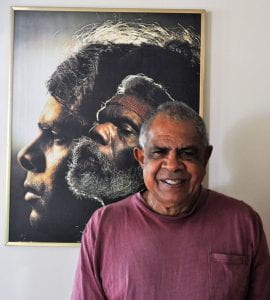Reflecting on Lyndall Ley’s call to do more for Indigenous communities across Australia, Paula Morrison reports on the achievements of her community in helping to rejuvenate the language of the local Gumbaynggirr people.
In 1986, five Gumbaynggirr elders who had been relocated off country, joined forces to begin the task of language revival for their children and grandchildren. In 2019, the International Year of Indigenous Languages this group, which has developed into the Muurrbay Aboriginal Language & Culture Co-operative, has much to celebrate.

Recordings of fluent language speakers had been made in the 1960s and 70s. Along with manuscripts of anthropology student, Gerhardt Laves, who collected phonetic transcriptions in the late 1920s and early 1930s, much material required painstaking analysis by the group, in consultation with community, and the expertise of linguists. Gradually, from these early word lists and little bits of recorded language, structures began to emerge, pronunciations refined, and dictionaries and grammars could be produced. Borrowing from traditional forms, words have had to be created to address new concepts. Now my school library greets students at the door with a sign: Darruyay yilaaming Janda-bibaa Baamgala which, literally translated, welcomes them to the ‘paper gather room’. Gary Williams, CEO of Muurrbay, says that although traditional stories had been told to him since his childhood, English language could only contain ’the bones’ of the story. In their original Gumbaynggirr language, details appeared that had previously been lost. For example, the word for ‘dawn’, bambuuda, literally means ‘in the soft’ part of the day, which adds to the atmosphere of the rising sun.
In 1997 Muurrbay became a Registered Training Organisation, focused on learning, research, and teaching. Adult classes commenced, and Gumbaynggirr also began to be taught in two Bowraville schools: St Mary’s Primary, and Bowraville Central. Over time, adults who studied through Muurrbay took the language program into more schools. This year over 28 schools, both government and private, offer Gumbaynggirr language classes to all students, and hundreds of adults have completed language courses. Several students have studied Gumbaynggirr for their Higher School Certificate. Gumbaynggirr is now being spoken as part of daily life, and is routinely used for texting. As the language use has grown, so has a sense of belonging and identity within the community. School language teachers report that students take the language home to teach their families.
Now my school library greets students at the door with a sign: Darruyay yilaaming Janda-bibaa Baamgala which, literally translated, welcomes them to the ‘paper gather room’.
Muurrbay has been so successful in revitalizing language that in 2004 their role expanded to become a Regional Language Centre. Their experience has enabled them to lead other language groups through the ‘Many Rivers’ Project, which offers strategic, project planning, linguistic, and IT support, as well as teaching expertise to six other language groups along the New South Wales coast who are engaged in their own language revitalisation projects. To date, Muurrbay has published over 20 titles to support teaching and language, and is currently working on a joint project with Sydney University for students to access Muurrbay’s language programs in an online setting.
Awareness of the revitalisation has spread throughout the wider community. Gary Williams presents a regular language segment on local ABC radio, and is often approached by locals who’ve learned a word or two. A Business Advisory Committee approached the Nambucca Council with the recommendation that all road signage be dual language, and this proposal was unanimously passed as policy in March, 2019. All new road signs, and those being replaced will now be in English and Gumbaynggirr. Library spaces are utilised for community language classes and story time sessions with elders.
At Nambucca Heads High School, a ‘Junior Lands Council’ was formed in 2011. Students, both indigenous and non, began with projects such as creating metal letterboxes and park benches, and then restored a vacant area of land into a park with a level playing field, orchard, children’s playground, and gazebo. The park was recently dedicated to the memory of a student with a sculpture garden designed and created by students, whose enterprise was rewarded with funding from other agencies as a joint project.
As the revitalisation of the Gumbaynggirr language continues, opportunities for employment increase, and further entrepreneurial ideas emerge as possibilities. Gary Williams reports a profound effect upon the community, with an increased sense of pride and personal identity.
Paula Morrison
Teacher-Librarian
Nambucca Heads High School
This article was originally published in Volume 40, Issue 5/6 of INCITE, which can be found at https://www.alia.org.au/sites/default/files/documents/INCITE%20May-June%202019.pdf. INCITE is the Member magazine of the Australian Library and Information Association.
